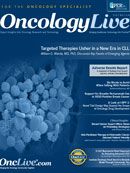Publication
Article
Oncology Live®
Obinutuzumab Gains Role in CLL Guidelines
Author(s):
Amid advances in targeted therapies for patients with chronic lymphocytic leukemia (CLL), researchers also have been making strides in the realm of chemoimmunotherapy regimens for the disease.
Image courtesy of Genentech
This illustration depicts the obinutuzumab antibody binding to the CD20 antigen on the B-cell surface.
Amid advances in targeted therapies for patients with chronic lymphocytic leukemia (CLL), researchers also have been making strides in the realm of chemoimmunotherapy regimens for the disease.
In November, the FDA approved obinutuzumab (Gazyva) in combination with chlorambucil for patients with previously untreated CLL. The first-in-class glycoengineered type-2 antibody has demonstrated superior outcomes in combination with chlorambucil to both a rituximab (Rituxan) plus chlorambucil regimen and to chlorambucil alone.1,2
The obinutuzumab combination has been incorporated into the National Comprehensive Cancer Network (NCCN) guidelines.3 (Table). The NCCN guidelines panel will discuss the most current research when it meets in June to consider any further updates, according to William G. Wierda, MD, PhD, who serves on the panel. Wierda discussed therapies for CLL at the 18th Annual International Congress on Hematologic Malignancies®: Focus on Leukemias, Lymphomas, and Myeloma. Physicians’ Education Resource®, LLC, hosted the conference on February 14-15 in New York City.
Clinical trial findings published in The New England Journal of Medicine4 in January support the efficacy of obinutuzumab for older-age patients and those with comorbidities or renal insufficiencies, said Wierda, who is a professor at The University of Texas MD Anderson Cancer Center in Houston, in an interview during the conference.
“If I have a patient who needs front-line therapy who is elderly and who is not appropriate for standard chemoimmunotherapy with fludarabine, cyclophosphamide, and rituximab, my first choice would be obinutuzumab plus chlorambucil,” Wierda said. “The data clearly support that as a superior treatment over other treatment options for the elderly patient population or patients with comorbidities.”
Table. NCCN Guidelines for Obinutuzumab in CLL1
Frail patient with significant comorbidity
(not able to tolerate purine analogues)
- Obinutuzumab + chlorambucil as 1st preference
First-line therapy for patients without del 11q or 17p
- Obinutuzumab + chlorambucil as 1st preference for patients aged ≥70 y, or younger with comorbidities
- Obinutuzumab + chlorambucil among chemoimmunotherapy options for patients aged <70 y, or older without significant comorbidities
First-line therapy for patients with del 17p
- Obinutuzumab + chlorambucil among combination therapy options
First-line therapy for patients with del 11q
- Obinutuzumab + chlorambucil as 1st preference for patients aged ≥70 y, or younger with comorbidities
- Obinutuzumab + chlorambucil among chemoimmunotherapy options for patients aged <70 y, or older without significant comorbidities
The phase III German CLL Study Group trial enrolled 781 patients with a median age of 73 years, a creatinine clearance of 62 mL per minute, and a median baseline score of 8 on the Cumulative Illness Rating Scale, according to Goede at al. In the three-arm trial, patients were randomized to receive chlorambucil plus either obinutuzumab or rituximab, or chlorambucil alone.
Both combination regimens delivered better outcomes than chlorambucil alone. Moreover, the obinutuzumab combination significantly prolonged progression-free survival (HR = 0.39; 95% CI, 0.31-0.49; P <.001) and demonstrated higher rates of complete response (20.7% vs 7.0%) compared with the rituximab regimen.
In terms of adverse events (AEs), researchers reported higher rates of AEs of grade 3 or higher severity among patients who received chlorambucil, with neutropenia and infusion-related reactions among the two most frequently reported AEs.
References
- Goede V, Fischer K, Humphrey K, et al. Obinutuzumab (GA101) plus chlorambucil (Clb) or rituximab (R) plus Clb versus Clb alone in patients with chronic lymphocytic leukemia (CLL) and preexisting medical conditions (comorbidities): final stage 1 results of the CLL11 (BO21004) phase III trial. J Clin Oncol. 2013;31(suppl; abstr 7004).
- Goede V, Fischer K, Busch, et al. Head-to-head comparison of obinutuzumab (GA101) plus chlorambucil (Clb) versus rituximab plus Clb in patients with chronic lymphocytic leukemia (CLL) and co-existing medical conditions (comorbidities): final stage 2 results of the CLL11 trial. Presented at: 55th ASH Annual Meeting; December 7-10, 2013; New Orleans, LA. Abstract 6.
- National Comprehensive Cancer Network. NCCN Clinical Practice Guidelines in Oncology: non-Hodgkin’s lymphomas Version I.2014. Updated December 20, 2103. Accessed March 8, 2014.
- Goede V, Fischer K, Busch R, et al. Obinutuzumab plus chlorambucil in patients with CLL and coexisting conditions [published online January 8, 2013]. N Engl J Med. doi:10.1056/NEJMoa1313984.

























%20(2)%201-Recovered-Recovered-Recovered-Recovered-Recovered-Recovered-Recovered-Recovered-Recovered-Recovered-Recovered-Recovered-Recovered-Recovered-Recovered-Recovered-Recovered.jpg?fit=crop&auto=format)
%20(2)%201-Recovered-Recovered-Recovered-Recovered-Recovered-Recovered-Recovered-Recovered-Recovered-Recovered-Recovered-Recovered-Recovered-Recovered-Recovered-Recovered-Recovered.jpg?fit=crop&auto=format)
